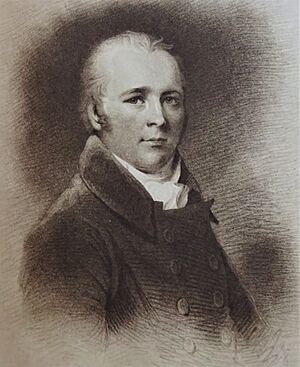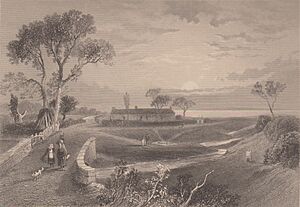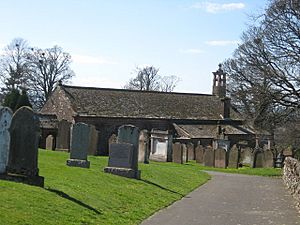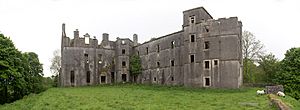John Syme (lawyer) facts for kids
Quick facts for kids
John Syme
|
|
|---|---|
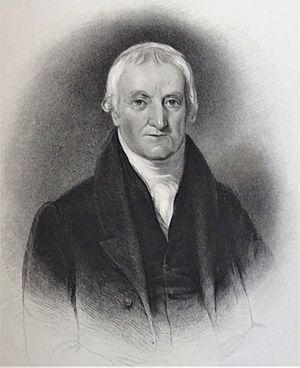
John Syme
|
|
| Born | 1755 Barncailzie
|
| Died | 24 November 1831 Dumfries
|
| Occupation | Lawyer / Writer to the Signet |
John Syme (1755 – 1831) was a Scottish lawyer. He was one of the closest friends of the famous poet Robert Burns during Burns's time in Dumfries. Syme and Burns went on two short trips to Galloway in 1793 and 1794.
After Burns passed away, Syme and another friend, Alexander Cunningham, helped raise money for Burns's family. They also helped fund a special memorial for the poet. Syme, along with Dr. William Maxwell, organized Burns's funeral.
Contents
John Syme's Early Life and Career
John Syme was born in 1755. His father was the Laird (landowner) of Barncailzie in Kirkcudbrightshire. John studied in Edinburgh. He also served as an ensign in the 72nd Regiment of Foot, which was a military unit.
Later, he left the army to manage his family's estate. However, his family lost their property due to financial problems. Syme had tried new farming methods at Barncailzie.
In 1791, Syme started working as a lawyer in Dumfries. His office was very close to where Robert Burns and his family lived. Like his father, Syme became a Writer to the Signet. This meant he was a type of lawyer who prepared legal documents.
In 1791, he also became the King's Distributor of Stamps. He collected taxes on things like land sales in the Dumfries area.
Syme's Family and Home
Syme and his family lived at Ryedale House. This was a small estate near the River Nith in Troqueer. Syme married Jane Millar, but she passed away in 1809.
John Syme died on November 24, 1831, when he was 76 years old. He was buried next to his wife in Troqueer Kirkyard. He lived 35 years longer than his friend Robert Burns.
Syme also managed the estate for his old school friend, Dr. James Currie. This estate was near Moffat. Syme sometimes worked as a surveyor for Currie. They were both on the committee for the Dumfries and Galloway Horticultural Society. They also enjoyed hunting together.
In 1795, Syme joined the Royal Dumfries Volunteers. Robert Burns and other friends also joined this group. They formed this volunteer force because they were worried about a possible French invasion.
William McDowall wrote about Syme in 1867. He described Syme as a "fine specimen of the old Scottish gentleman." He said Syme was smart, kind, well-educated, and polite. He was also full of interesting stories and jokes.
John Syme and Robert Burns
Syme first met Burns when the poet lived at Ellisland Farm. Burns would visit Dumfries weekly to get his mail. In 1790, Syme had breakfast at Ellisland and met Burns's wife, Jean Armour.
Syme and Burns also met at John Bushby's home in Tinwald. Syme greatly valued Burns's company. In 1793, he wrote that without Burns, "I should feel a dreary blank in the society of this town." He also said, "I see Burns frequently, and love him more and more."
Burns thought very highly of Syme. He called Syme his "Supreme Court of Critical Judicature." This meant he trusted Syme's judgment completely.
Burns often visited Syme's home, Ryedale House. Burns even wrote two short poems about Syme. One of them said:
|
"No more of your guests, be they titled or not, |
In 1794, Burns sent Syme a case of beer. He included a verse with it:
|
"O had the malt thy strength of mind, |
Burns also mentioned Syme in a poem called the Second Heron Election Ballad:
|
"An there'll be Stamp-Office Johnie: |
Syme owned a book called the Della Cruscan British Album. Burns wrote some lines inside it:
|
"PERISH their names, however great or brave, |
The "despot" in these lines was a reference to the prime minister, William Pitt.
Syme enjoyed collecting Burns's short, witty poems called epigrams. Many of these were funny but sometimes criticized people who could have helped Burns's career. Syme did not expect all of them to be published. These writings are now in two special manuscripts.
One time, Burns wrote on a drinking glass at Ryedale with his diamond-point pen. Syme was annoyed that his crystal glasses were marked. He threw the glass under the fireplace. However, his clerk saved it, and it became a valuable item. The writing on the glass was:
|
In 1792, Burns asked Syme to help him get his family crest carved onto a stone. Burns had created his own crest.
Burns had received a warning from his job (the Excise) for getting involved in politics. In 1793, Syme suggested that Burns should be less political. He advised Burns to write about less controversial topics. This made Burns very angry. Syme said Burns's eyes turned red like coals. Burns almost drew his sword on Syme. But when he realized what he was doing, he apologized.
Burns and Syme's Galloway Tours
On July 27, 1793, Syme went with Burns on his first trip to Galloway. On the first day, they had dinner with the landowner John Gordon at Kenmure Castle. They also sailed on Loch Ken.
A story from this trip tells how Burns helped an old clergyman. The clergyman was too weak to jump from the boat to land. Burns immediately stepped into the water, which was deep. He then carried the clergyman on his shoulders to the shore. Syme laughed and said, "Well Burns, of all the men on earth, you are the last that I could have expected to see priest-ridden!" Burns did not find the joke funny. He was probably thinking about his expensive new boots, which got ruined.
Burns is said to have recited a prayer known as the 'Selkirk Grace' during this trip.
According to Syme, Burns gave him a copy of his famous poem 'Scots Wha Hae' on August 1, 1793. Burns had recently visited the Battle of Bannockburn site. This visit and other experiences on their journey likely inspired this great poem.
From June 26 to 28, 1794, Syme joined Burns on a second short trip to Galloway. Burns did not mention this trip to James Currie. A few letters give some details, but no journal was kept. They visited Syme's friend Patrick Heron at his Kerroughtree Estate. Syme had written to Heron about Burns. Burns hoped Heron would use his political influence to help him get a promotion at his job.
The Death of Robert Burns
Syme visited Burns at the Brow Well on July 15, 1796. He also saw his friend a few days later at Burns's home in Dumfries. Syme wrote about Burns's condition at the Brow Well.
On July 17, Syme wrote to Alexander Cunningham. He said Burns was "in a very bad state of health." He was very worried about Burns's appearance and how weak he was. He hoped Burns would recover with care and the help of Dr. Maxwell.
On the following Tuesday, after visiting Burns at his Dumfries home, Syme wrote again. He said he believed it was "all over with him." He had just left Burns's room and saw "the expiring genius of Scotland departing with Burns." Dr. William Maxwell had told him there was no hope. Syme said he could not talk more about the sad scene.
On Thursday, July 21, Syme wrote that "Burns departed this morning at 5 o'clock." He said he could not write more about the sad event.
Jean Armour Burns told Syme that Burns called for him and Alexander Cunningham on his deathbed. Burns's last words are said to have been: "Maxwell! Macmurdo! Syme! will none of you relieve me?"
Syme wrote down some emotional memories of Burns. He said Burns's face changed constantly with his thoughts. His eyes and lips showed what he was about to say. Syme said Burns's eyes were like "coals of a living fire" when he was angry about unfairness or meanness.
Only one letter from Burns to Syme still exists. They lived close by, so they did not need to write many letters. In one letter, Burns wrote positively about the Oswald family of Auchencruive. He praised Mr. Oswald's wealth, pleasant looks, kind nature, and intelligence. He also admired Mrs. Oswald.
Syme's Role in Burns's Biography
Syme was one of the people who convinced Dr. James Currie to write a biography of Robert Burns. Currie was not eager to do it. Syme spent three weeks at Currie's home in Liverpool to help him. Gilbert Burns, Robert's brother, also joined them.
Syme wrote to James Currie, asking him to tell people about the fundraising for Jean and her children. As a result, Currie raised a good amount of money from his wealthy friends in Liverpool.
Burns's First Commonplace Book
Burns's Commonplace Book of 1783–1785 was the first of three personal notebooks kept by the poet. It contained early versions of songs and poems, thoughts, and ideas.
Throughout these notebooks, you can find comments and changes. Some were made by Robert Burns himself. Others were made by John Syme, James Currie, and others. These notes can be identified by the handwriting and ink. As mentioned, Syme visited James Currie in Liverpool with Gilbert Burns. James Currie had this notebook from January 1797.
Syme's Letters with Alexander Cunningham
Only one letter from Burns to Syme is known. However, many letters between Syme and Alexander Cunningham still exist.
About ninety letters were exchanged between Syme and Cunningham from 1786 to 1811. These letters were found in the Cunningham family records 120 years later. They offer many interesting details about Robert Burns's life.
In 1797, Syme and Cunningham asked to borrow Burns's letters for a book to be published after his death. However, Agnes Maclehose (Clarinda) asked for her letters back. Robert Ainslie also visited to make sure her demand was met. The trustees eventually returned the letters.
Syme, William Grierson, Alexander Cunningham, and James Currie (through his biography) were key in raising money for a proper memorial for Burns. Burns's body was moved to this memorial in September 1815. Cunningham also helped get James Currie to write Burns's biography.
Syme received a letter from Alexander Cunningham. Cunningham expressed his sadness that many of Burns's supposed friends did not donate to the fund. Instead, they offered "cold civility and humiliating advice."
See also
- Robert Aiken
- Robert Ainslie
- Jean Armour
- John Ballantine
- Lesley Baillie
- Alison Begbie
- Nelly Blair
- Isabella Burns
- May Cameron
- Mary Campbell (Highland Mary)
- Jenny Clow
- Gavin Hamilton (lawyer)
- Helen Hyslop
- James McKie


